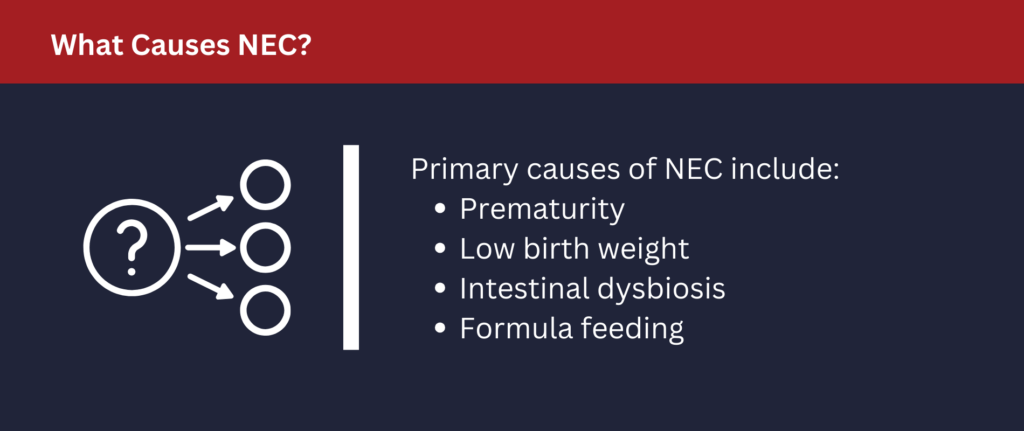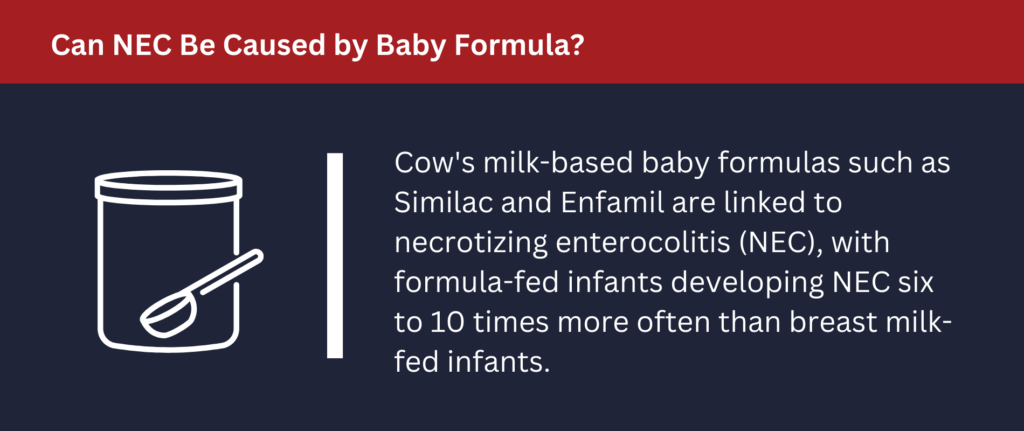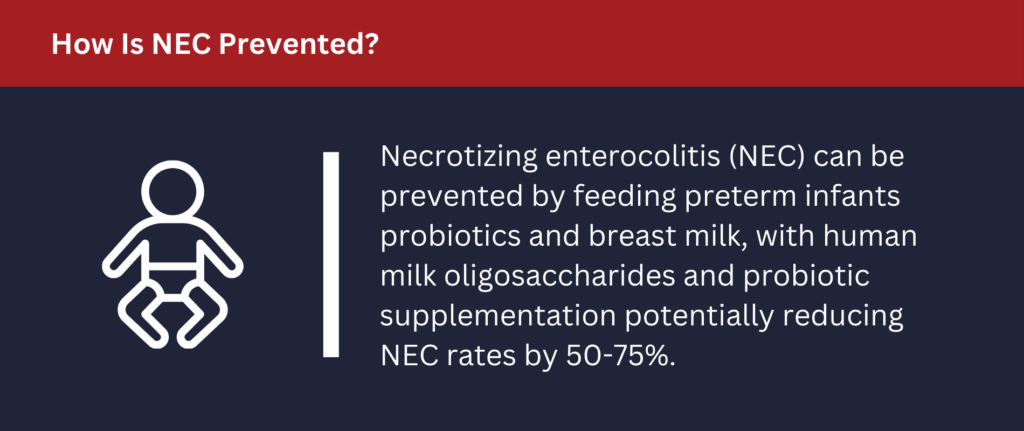
Necrotizing enterocolitis (NEC) is a catastrophic disease of the intestines that affects very low birth weight or premature infants. The symptoms of NEC can include bloating, poor feeding, blood in the stool, decreased activity, bowel death, vomiting of bile, and multi-organ failure. NEC can be fatal.
It is unclear what the exact cause of NEC is, but multiple risk factors have been found. Risk factors for NEC include formula feeding, prematurity, low birth rate, and intestinal dysbiosis. Some maternal factors are also linked to NEC development but have not been consistently implicated.
Other potential risk factors include birth asphyxia, congenital heart disease, pre-labor rupture of membranes, and exchange transfusion. The underlying mechanism behind NEC is thought to involve a combination of intestinal infection and poor blood flow. Diagnoses are based on symptoms and medical imaging confirms diagnoses.
The use of breast milk and probiotics may prevent NEC. Treatment for NEC includes orogastric tubes, bowel rest, intravenous antibiotics, and intravenous fluids. Infants with free air in the abdomen require surgery. Numerous other supportive measures may also be needed. Complications of NEC can include developmental delay, intestinal strictures, or short-gut syndrome.
Around seven percent of prematurely born infants develop NEC, but the odds of infants developing NEC are directly related to the ICU they are put in. NEC’s onset usually occurs in the first four weeks of an infant’s life. About 25 percent of those who develop NEC die. Males and females are affected by NEC equally. NEC was first described between 1888 and 1891.
What Are the Symptoms of NEC?
NEC is usually seen in prematurely born infants, and the earlier an infant is born, the longer it usually takes for the symptoms of NEC to appear.
The initial symptoms of NEC include failure to thrive, feeding intolerance, abdominal distension, bloody stools, and increased gastric residuals. The symptoms of NEC can rapidly progress to abdominal discoloration with peritonitis and intestinal perforation, and systemic hypotension which necessitates intensive medical support.
NEC is usually seen in prematurely born infants, and the earlier an infant is born, the longer it usually takes for the symptoms of NEC to appear.
The initial symptoms of NEC include failure to thrive, feeding intolerance, abdominal distension, bloody stools, and increased gastric residuals. The symptoms of NEC can rapidly progress to abdominal discoloration with peritonitis and intestinal perforation, and systemic hypotension which necessitates intensive medical support.
What Causes NEC?

NEC’s exact cause is not clear. Multiple risk factors for NEC development have been suggested:
Primary factors include:
• Prematurity
• Low birth rate
• Intestinal dysbiosis
• Formula feeding
Maternal factors include:
• Chorioamnionitis
• Acid-suppressing drugs
• Abuse of cocaine
• Increased body mass index
• In utero growth restriction
• Lack of prenatal steroids
• Intrahepatic cholestasis during pregnancy
• Placental abruption
• Mode of delivery
• Smoking
• Preeclampsia
Other factors include:
• Antibiotic exposure
• Acute hypoxia
• Cardiac anomalies
• Blood transfusions
• Poor intestinal perfusion
• Neonatal anemia
• Prolonged use of indomethacin
There may be a link between NEC and the gut being colonized by pathogenic flora; breast milk’s protective effect may be related to Lactobacillus species which repair the intestinal environment.
NEC susceptibility may be affected by genetics.
Multiple medications have been suggested as risk factors for NEC development, including:
• Theophylline
• Aminophylline
• Indomethacin
• Vitamin E
• Gastric antacids
• Ranitidine
Some of these factors may qualify victims for a birth injury claim.
Can NEC Be Caused by Baby Formula?

Multiple scientific studies, articles, and trials have linked cow’s milk-based baby formulas, such as Similac and Enfamil, with NEC:
• A 1990 clinical trial found that six to 10 times more exclusively formula-fed infants developed NEC than infants who were fed only breast milk and that three times more infants who received breast plus formula milk developed NEC than infants who were fed only breast milk. The trial also found that 20 times more infants born at over 30 weeks’ gestation who were exclusively fed formula developed NEC compared to infants with diets that included breast milk.
• A 2007 study found that 10.6 percent of babies given less than half-human milk developed NEC, compared to only 3.2 percent of infants given more than half-human milk developing NEC.
• A 2012 study found that lipase digestion in vitro of formula led to high unbound free fatty acid levels which caused intestinal cells to die, but that it didn’t occur with lipase digestion in vitro of human breast milk.
• A 2014 study found that 3.4 percent of infants who received cow’s milk-based formula developed NEC compared to only 1 percent of infants who received human breast milk developing NEC.
• A 2014 author manuscript stated, “it is well established that the risk of [NEC] is increased by the administration of infant formula.”
• A 2016 study found that 16.7 percent of infants who received preterm formula and/or human breast milk fortified with bovine fortifier developed NEC. The study found that only 6.9 percent of infants given human breast milk developed the condition.
• A 2017 article stated, “bovine milk-based infant formulas lead to a higher incidence of NEC in preterm infants than does human milk.”
• A 2018 article noted that preterm infants who receive human milk rather than formula are six to 10 times less likely to develop NEC. The article suggests that the oligosaccharides in human breast milk might reduce the risk of NEC development.
What Baby Formulas Can Cause NEC?
The manufacturers of Similac and Enfamil are facing multiple lawsuits claiming that they knew their products could cause NEC but failed to warn the public about the risk. Similac and Enfamil formulas that may cause NEC include:
• Similac Alimentum
• Similac
• Similac Human Milk Fortifier
• Similac Alimentum Expert Care
• Similac Human Milk Fortifier Hydrolyzed Protein Concentrated Liquid
• Similac Human Milk Fortifier Concentrated Liquid
• Similac Liquid Protein Fortifier
• Similac Human Milk Fortifier Powder
• Similac Pro-Advance
• Similac NeoSure
• Similac Special Care
• Similac Pro-Sensitive
• Similac Special Care 24
• Similac Special Care 20
• Similac Special Care 30
• Similac Special Care 24 High Protein
• Enfamil
• Enfacare Powder
• Enfamil 24 and DHA u0026 ARA Supplement
• Enfamil 24 Cal
• Enfamil Human Milk Fortifier Acidified Liquid
• Enfamil Human Milk Fortifier
• Enfamil Human Milk Fortifier Powder
• Enfamil Human Milk Fortifier Liquid High Protein
• Enfamil NeuroPro Enfacare
• Enfamil Milk Fortifier Liquid Standard Protein
• Enfamil Premature 24 Cal
• Enfamil Premature 20 Cal
• Enfamil Premature 30 Cal
• Enfamil Premature 24 Cal/fl oz HP
How Is NEC Treated?
Treatment should be started immediately when an infant is diagnosed with NEC. Treatment of NEC consists mostly of supportive care, including:
• Gastric decompression with intermittent suction
• Providing bowel rest by stopping enteral feeding
• Support for blood pressure
• Fluid repletion to correct third-space losses and electrolyte abnormalities
• Prompt antibiotic therapy
• Parenteral nutrition
Monitoring of NEC is clinical. Left lateral decubitus abdominal and serial supine X-rays should be performed every six hours.
Feeding is gradually introduced as infants recover from NEC. Low-volume feeds are typically first initiated. What and how to feed are determined by the infant’s clinical appearance, the need for surgical intervention, and the extent of bowel involvement.
When NEC isn’t halted through medical treatment alone, or when a perforated bowel is involved, it is usually necessary to perform immediate emergency surgery to resect the dead bowel. Abdominal drains may be placed as a temporizing measure in extremely unstable infants. Surgery may need a colostomy, which might be reversed later. Short bowel syndrome can result when extensive parts of the bowel need to be removed.
When infants’ bowels are left in discontinuity, it may be helpful to surgically create a mucous fistula or a connection to the distal bowel. This allows for the refeeding of ostomy output to the distal bowel. It is believed that this improved bowel adaptation and aids in the advancement of feeding.
How Is NEC Diagnosed?
NEC diagnosis is usually clinically suspected, but often necessitates the help of diagnostic imaging, usually radiography, which can display the intestines and may display a bowel perforation or areas with tissue death. Specific signs of NEC seen during radiography are associated with specific stages of NEC:
Bell’s Stage 1 (Suspected NEC)
• Mild intestinal symptoms, such as bloody stools, increased gastric residuals, and abdominal distention
• Mild systemic symptoms, such as temperature instability, slowed heart rate, lethargy, and apnea
• Normal or nonspecific radiological signs
Bell’s Stage 2 (Definite NEC)
• Additional intestinal symptoms, such as abdominal tenderness and absent bowel sounds
• Mild to moderate systemic symptoms
• Laboratory changes, such as insufficient platelets in the blood, metabolic acidosis
• Specific radiological signs, such as portal venous gas or pneumatosis intestinalis
Bell’s Stage 3 (Advanced NEC)
• Additional intestinal symptoms, such as peritonitis or striking abdominal distention
• Severe systemic symptoms, such as low blood pressure
• Additional laboratory changes, such as disseminated intravascular coagulation or metabolic and respiratory acidosis
• Severe radiologic signs, such as pneumoperitoneum
Ultrasonography has been shown to be useful for NEC diagnosis since it might detect complications and signs of NEC before radiography can. This is true specifically in instances of a sentinel loop, a gasless abdomen, or a scarcity of bowel gas. Five to 10 percent of infants weighing less than 1,500 grams are ultimately diagnosed with NEC.
Diagnosing NEC is more difficult in premature infants, due to radiographic signs and inexplicit symptoms. The more premature an infant is born, the higher the risk that they develop NEC.
How Is NEC Prevented?

NEC prevention involves using probiotics and breast milk. The American Academy of Pediatrics, in 2012, recommended feeding human milk to preterm infants, saying that doing so comes with “significant short- and long-term beneficial effects,” including a reduction in NEC rate by 50 to 75 percent.
Feeding low birth weight infants small amounts of human milk, orally, as soon as possible, while the infant is being mostly fed intravenously, stimulates an immature gut to mature and eventually be ready to receive greater oral intake of human milk. When mother’s milk is not available, human milk from a donor or milk bank may be used.
It has been noted by experts that the glycan and immunoglobular compositions of cow’s milk and human milk are different, and this has implications on our understanding of why human milk can prevent NEC. Human milk oligosaccharides are a subject of interest in intervention and supplementation because they are relatively easy to produce.
A 2020 review found that probiotic supplementation may prevent “severe NEC, as well as all-cause mortality in preterm infants.”
What Is the Prognosis of NEC?
Typical NEC recovery when nonsurgical treatment is successful includes ten to 14 days or more without oral feeding, and then the demonstrated abilities to gain weight and resume feeding. Recovering from NEC can be compromised by the co-morbid conditions frequently accompanying premature birth. Long-term NEC complications include anemia and bowel obstruction.
NEC caused 355 deaths per 100,000 live births in 2013 in the United States. This was down from 484 per 100,000 live births in 2009.
The prognosis for infants is typically very good when NEC is diagnosed and treated immediately. Most infants fully recover without additional health issues. Around 70 to 80 percent of infants diagnosed with NEC survive. Infants with NEC who are medically managed are more likely to survive than infants who are surgically managed.
While there is a significant risk of mortality involved with surgical management of NEC, the long-term prognosis for infants requiring surgical management of NEC is improving, with survival rates of 70 to 80 percent.
However, survivors of surgical management of NEC may still develop long-term complications, such as neurodevelopmental disability, short bowel syndrome, or narrowing of the intestines.
The mortality rate of NEC for infants who weigh less than 1,500 is very high—over 50 percent.
Necrotizing enterocolitis (NEC) is a catastrophic disease of the intestines which affects very low birth weight or premature infants. The symptoms of NEC can include bloating, poor feeding, blood in the stool, decreased activity, bowel death, vomiting of bile, and multi-organ failure. NEC can be fatal.
It is unclear what the exact cause of NEC is, but multiple risk factors have been found. Risk factors for NEC include formula feeding, prematurity, low birth rate, and intestinal dysbiosis. Some maternal factors are also linked to NEC development but have not been consistently implicated.
Other potential risk factors include birth asphyxia, congenital heart disease, pre-labor rupture of membranes, and exchange transfusion. The underlying mechanism behind NEC is thought to involve a combination of intestinal infection and poor blood flow. Diagnoses are based on symptoms and medical imaging confirms diagnoses.
The use of breast milk and probiotics may prevent NEC. Treatment for NEC includes orogastric tubes, bowel rest, intravenous antibiotics, and intravenous fluids. Infants with free air in the abdomen require surgery. Numerous other supportive measures may also be needed. Complications of NEC can include developmental delay, intestinal strictures, or short-gut syndrome.
Around seven percent of prematurely born infants develop NEC, but the odds of infants developing NEC are directly related to the ICU they are put in. NEC’s onset usually occurs in the first four weeks of an infant’s life. About 25 percent of those who develop NEC die. Males and females are affected by NEC equally. NEC was first described between 1888 and 1891.
Contact Nadrich Accident Injury Lawyers Today
Call us, text us from this page, or contact us online today for a free consultation if your infant developed NEC after being given Similac or Enfamil formula. You may be entitled to financial compensation, and we don’t charge a fee until and unless we win your case.

